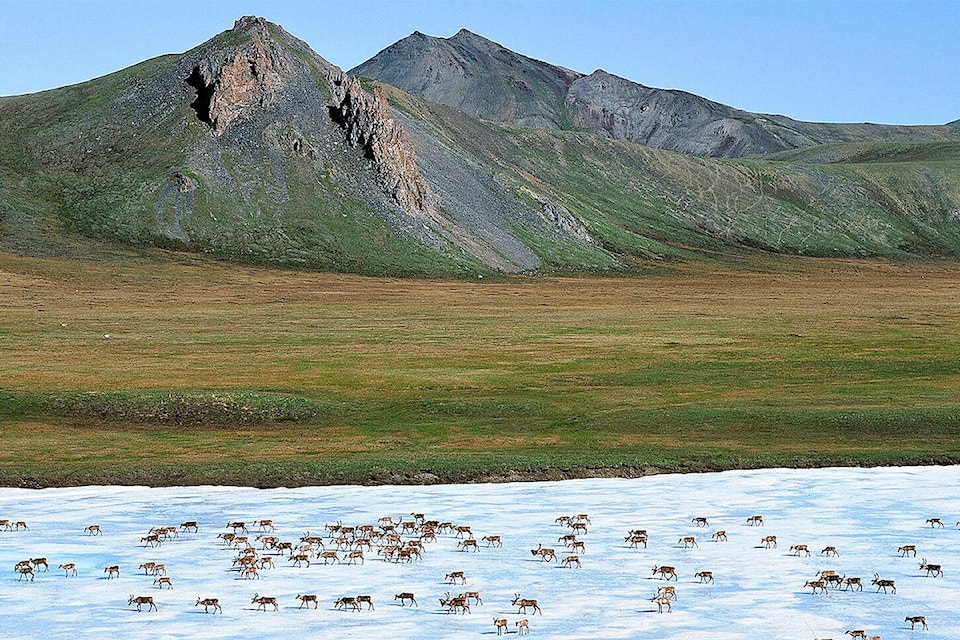A senior official at the U.S. Department of the Interior suggested that a new monitoring program would not be created to track Porcupine caribou herd, which could be impacted by oil and gas development’s likely move into part of the Arctic National Wildlife Refuge (ANWR).
“One of the things that I think is maybe not understood is between the state and federal governments, as well as the Canadian governments on the other side of the border, is that each regime monitors caribou, regardless of whether we have a drilling program or not,” said Joe Balash, assistant secretary for land and minerals at the Interior department, during a press conference on Feb. 13 in Washington D.C.
The News asked Balash about some of the findings of a report commissioned by the Yukon, NWT and Canadian government released last week, which addresses the Bureau of Land Management’s draft environmental impact statement that concerns opening up ANWR’s coastal plain to development.
The Canadian report says there’s a lack of evidence to support mitigation effectiveness and “almost no information on monitoring and adaptive management” when it comes to the Porcupine caribou.
Some Iñupiat communities claim that researchers in low-flying aircrafts are disturbing the caribou when conducting monitoring efforts, “which has a negative impact on subsistence hunters,” Balash said.
“I don’t think you’re going to see anything from us that requires a lot of low-level flight disturbance in the communities’ vicinity.”
Balash said he hasn’t had the opportunity to review the report himself, but that departmental experts have taken an “initial look.”
“My understanding is the authors of that particular study are very well-regarded in the Canadian wildlife community, and so we’re going to pay very close attention to what it is they have to offer and what observations they’ve made, because, at the end of the day, we need to get things right,” he said.
That aside, he continued, it’s unclear whether the authors “fully understand” all of the mitigation proposals.
“And I think, as it’s been reported to me anyway, they may have some fundamentally wrong understandings about how a program development might turn out.”
Four options in the draft plan provide different degrees of protection for the herd, it says.
Two involve providing lease sales for the entire program area, roughly 1.5 million acres. The remaining options say portions of the coastal plain would be off limits to oil and gas interests. No surface occupancy, a prohibition of all or some surface disturbances, would apply to each one in certain areas within the coastal plain, also referred to as 1002.
“Every single one of our alternatives takes some step to protect or mitigate impacts on the caribou in the core calving area during the calving period,” Balash told reporters.
Mitigation stipulations included in the draft plan — no surface occupancy or time restrictions, for instance — could be short-lived because they could be waived, a Yukon government biologist told the News this week.
One option, “a no action alternative,” which proposes offering up no mineral resources whatsoever, is seemingly irrelevant.
In December, around the time the draft plan was published, Balash said, “Realistically, Congress has told us to have this sale. Practically speaking, we will be moving forward here and implementing the law.”
The chair of the Porcupine Caribou Management Board disagrees the draft plan does enough to protect the caribou.
“The EIS is drastically inadequate in presenting scientifically proven mitigations that would be effective,” said Joe Tetlichi in a written statement. “It doesn’t consider adaptive management or cumulative impacts on the herd.”
“We are confident in what our scientists tell us,” he said, noting the report’s authors as having completed an “extensive review.”
Balash’s comments on Feb. 13 came at the end of an eight-day public meeting period, hosted in Alaskan communities and Washington.
The public comment period has been pushed back to Mar. 13.
He said the most “pressing” issue raised at the meetings concerned the fate of Porcupine caribou herd.
Balash shed light on the public’s reaction to proposed development, including within Indigenous communities, some of which appear to be at odds with each other. The Gwich’in people, he said, are “unanimously” opposed to development in the coastal plain. The Iñupiat are “overwhelming in favour,” he said. He called the reaction “mixed” in urban areas.
In 1987, Canada signed an international pact with the U.S. government to conserve the Porcupine caribou.
In December 2017, ANWR’s coastal plain was opened up to the possibility of oil and gas leases when the Trump administration inserted a provision in to the Tax Cuts and Jobs Act. The legislation stipulates that one lease must be issued in four years and that no fewer than two lease sales, each to include at least 400,000 acres with the highest potential of hydrocarbons, must occur by 2024.
Contact Julien Gignac at julien.gignac@yukon-news.com
